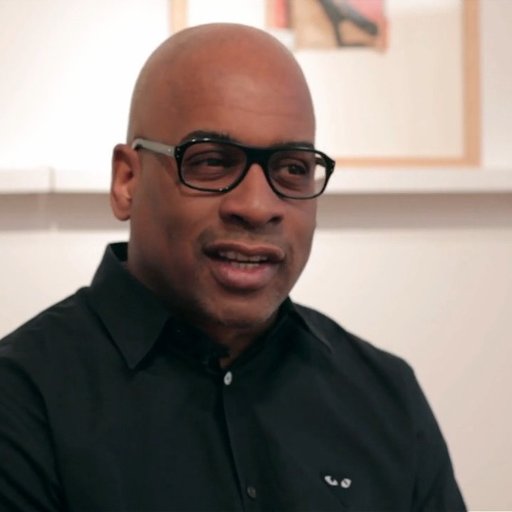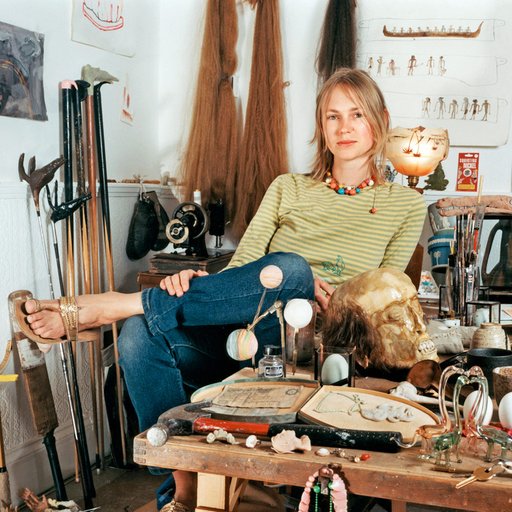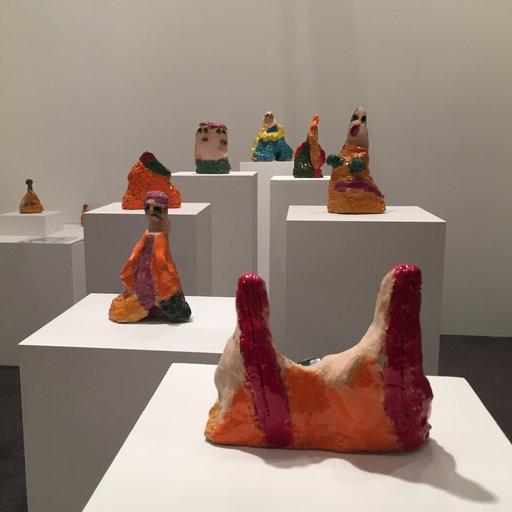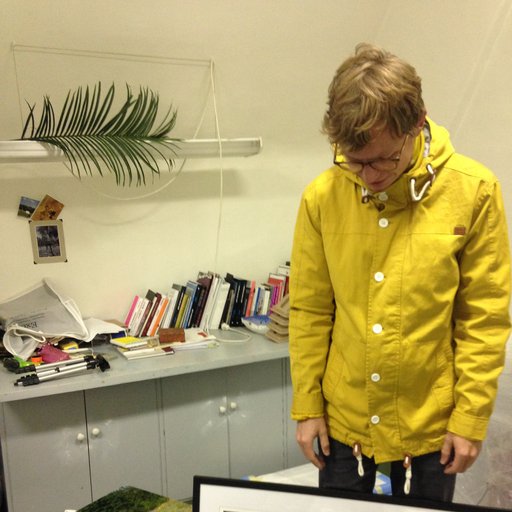From a South Korean master of venetian blinds to one of the most influential (and mysterious) African-American artists of our time, here are the figures the art world is buzzing about this month.
BARKLEY HENDRICKS
Jack Shainman Gallery, March 17 – April 23
Scour the street-style blogs for pictures from Pitti Uomo and London Fashion Week all you want—you’ll be hard pressed to find a more head-turningly dapper and sprezzatura-suffused cast of characters than those populating the paintings of Barkley Hendricks. A chronicler of African American style (and attitude) since the ‘60s who is often compared to Alice Neel but may be better linked to Manet, Hendricks has an eye for the sociologically telling detail, and in his new work—on display this month at Jack Shainman, in his second show there—he’s focusing his attention on youths sporting the athleisure style so in vogue today. While they may not seem to have the iconic stature of his work from decades past, give them a few years. The man is unstoppable, en route to the canon.
CAI GUO-QIANG
“What About the Art: Contemporary Art from China” at Qatar Museums, March 14-July 16
The Chinese artist Cai Guo-Qiang is known for his theatrical installations and performances involving gunpowder, but he also moonlights as a curator. He organized the Chinese Pavilion at the 51st Venice Biennale, and has now assembled an exhibition of Chinese contemporary art for the Qatar Museums Authority. Titled “What About the Art,” it aims to reorient the dialogue around Chinese contemporary art (which has been largely market-focused and political) to emphasize creativity and originality. The show’s 15 artists include some emerging talents in new media, among them the video-gamer designer Jenova Chen and the Apple factory infiltrator (and New Museum Triennial standout) Li Liao.
MARTIN PARR
Guildhall Art Gallery, March 4 – July 31; Barbican Art Gallery, March 16 - June 19
As the photographer-in-residence of the City of London for the past two years, Martin Parr has been able to capture the Queen and an assortment of dignitaries at private and public events (from the fancy-dress annual “Pancake Race” run by the Worshipful Company of Poulters to the 12th-century ceremony that involves releasing swans on the Thames.) These intriguing images are now on view in “Unseen City: Photos by Martin Parr,” at Guildhall Art Gallery; the Magnum photographer and Phaidon book subject has also curated the exhibition “Strange and Familiar,” at the Barbican.
NASREEN MOHAMEDI
Met Breuer, March 18 – June 5
The first U.S. museum retrospective of the Indian artist Nasreen Mohamedi (1937-1990) would be cause for celebration in itself, but the inauguration of the Met Breuer amplifies the sense of occasion. Mohamedi’s monochromatic paintings and drawings, which will be on view alongside the group show “Unfinished: Thoughts Left Visible,” exemplify modernism at its most international and cosmopolitan with floating shapes and grids drawn from the architectural details she frequently photographed. Also on view will be a selection of Mohamedi’s diaries, which reveal diverse sources of inspiration from Rainer Maria Rilke to the Sufi mystic Rumi.
DAVID HAMMONS
Mnuchin Gallery, March 15 – May 27
David Hammons is so reclusive he’s almost an urban legend—an artist who in the 1960s began making unforgettably poetic work about the African American experience out of castoff trash and his own body, in a way reminiscent of Arte Povera, but who long ago elided his own presence from the public, retreating from view and letting his work elliptically speak for him. (A few years back he did indulge one of his greatest fans, New Yorker critic Peter Schjeldahl, with a brief audience at a Starbucks.) Well, one of the art professionals with access to Hammons is the former Goldman-Sachs-rainmaker-turned-dealer Robert Mnuchin, a deep-feeling connoisseur who has shown two new series of the artist’s over the past decade—perhaps because Hammons is reputed to enjoy his financial talk blunt and colorful—and who now is presenting a survey of a half century of his work. Since Hammons doesn’t really work with museums much, this might be the last time you’ll be able to see this much of his work together in one place for a long, long while, so go see this show.
HAEGUE YANG
GreeneNaftali, March 4 - April 16
The South Korean artist Haegue Yang is best known for her sculptural assemblages, which range from large-scale installations of venetian blinds (a distinctive and recurring material) to vaguely humanoid constructions of natural and artificial materials held together by strings of lightbulbs and mounted on wheeled stands. These works aren’t simply gestures towards the compelling formal qualities of everyday objects, however; as the name of her upcoming Greene Naftali show (“Quasi-Pagan Minimal”) suggests, Yang uses these disparate items to make subtle claims about the continuing presence of what could be called “the sacred” in contemporary society.
SANFORD BIGGERS
moniquemeloche LES, March 3 – 6
An artist who dips into the many-splendored lore of the African American experience, Sanford Biggers has ranged over the years from Afrofuturism to hip hop and Buddhism as his source material, leading him, at one point in 2014, to begin making paintings out of quilts that he gathered from the progeny of slaveowners. Now, as part of an intriguing pop-up space that Chicago gallerist Monique Meloche is opening on the Lower East Side during Armory Week, Biggers will have several of these potent blankets on view alongside other mixed-media works by Ebony G. Patterson.
NATHAN MABRY
Cherry and Martin, March 19 - May 14
With references ranging from Modernism and conceptual art to popular culture and traditional craft techniques, Nathan Mabry’s work suggests a postmodern omnivore at its most voracious. This varied aesthetic diet results in a correspondingly diverse body of work, with the breaking down of hierarchies and humorous juxtaposition acting as guiding values for the Los Angeles-based sculptor. His fifth solo show at Cherry and Martin will feature new monochrome sheet metal sculptures dotted with cast birds—see if you can tease out the hidden meanings.
ROBERT MORRIS & KISHIO SUGA
Blum & Poe Tokyo, March 12 - May 2
Blum & Poe Tokyo’s upcoming show reactivates two older works by Robert Morris and Kishio Suga, giants of installation art who worked in very different contexts and milieus to realize their respective visions of ephemeral site-specific projects. Morris, an American artist based in New York whose influence extends to the development of Minimalism as well as Process and Land Art in the late ‘60s, is reactivating his 1969 piece Lead and Felt, a scattering of large L-shaped pieces of the eponymous materials; the Japanese conceptual artist Suga is similarly restaging his Parameters of Space, a 1978 stone-and-wooden-board arrangement.
LARRY BELL
Screening of Premium at Hauser & Wirth on March 3, 6 p.m.
Best known for his hypnotic translucent cube sculptures that mesmerized West Coast audiences in the 1960s as moonshot-era emblems of the Light and Space movement, Larry Bell is currently the subject of an eye-opening show at Hauser & Wirth’s Upper East Side location that fulsomely demonstrates the amplitude of the artist’s less familiar work. For instance, did you know that he was an actor too… very briefly? This week, on March 3rd at 6 p.m., the gallery is going to screen Premium, a 24-minute 1971 film that Ed Ruscha shot of his Los Angeles peer really going to town on a package of water crackers—a hilariously deadpan short movie based, it so happens, on the short story “How to Derive the Maximum Enjoyment From Crackers” by Mason Williams, a fascinating onetime “Smothers Brothers” musician and childhood friend of Ruscha’s who is having something of an artistic renaissance of his own these days.



























